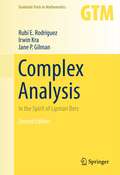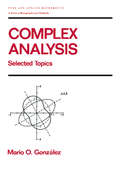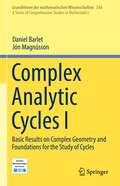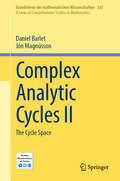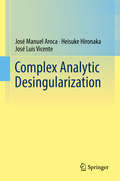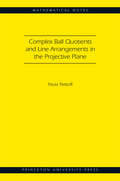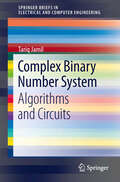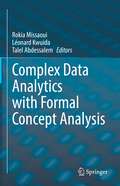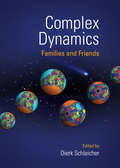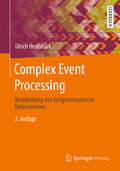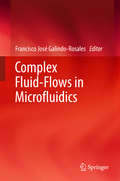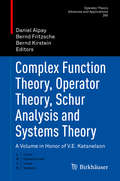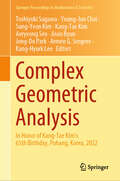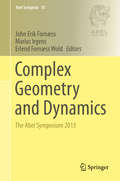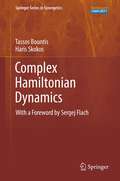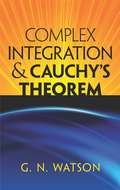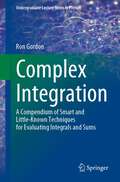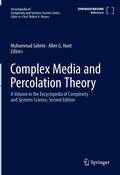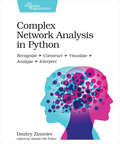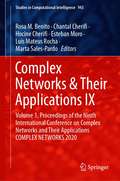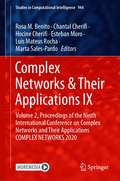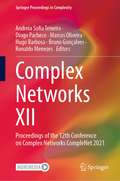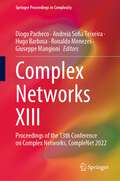- Table View
- List View
Complex Analysis: In the Spirit of Lipman Bers (Graduate Texts in Mathematics #245)
by Rubí E. Rodríguez Irwin Kra Jane P. GilmanThe authors' aim here is to present a precise and concise treatment of those parts of complex analysis that should be familiar to every research mathematician. They follow a path in the tradition of Ahlfors and Bers by dedicating the book to a very precise goal: the statement and proof of the Fundamental Theorem for functions of one complex variable. They discuss the many equivalent ways of understanding the concept of analyticity, and offer a leisure exploration of interesting consequences and applications. Readers should have had undergraduate courses in advanced calculus, linear algebra, and some abstract algebra. No background in complex analysis is required.
Complex Analysis: Selected Topics (Chapman And Hall/crc Pure And Applied Mathematics Ser. #152)
by Mario GonzalezA selection of some important topics in complex analysis, intended as a sequel to the author's Classical complex analysis (see preceding entry). The five chapters are devoted to analytic continuation; conformal mappings, univalent functions, and nonconformal mappings; entire function; meromorphic fu
Complex Analytic Cycles I: Basic Results on Complex Geometry and Foundations for the Study of Cycles (Grundlehren der mathematischen Wissenschaften #356)
by Daniel Barlet Jón MagnússonThe book consists of a presentation from scratch of cycle space methodology in complex geometry. Applications in various contexts are given. A significant portion of the book is devoted to material which is important in the general area of complex analysis. In this regard, a geometric approach is used to obtain fundamental results such as the local parameterization theorem, Lelong' s Theorem and Remmert's direct image theorem. Methods involving cycle spaces have been used in complex geometry for some forty years. The purpose of the book is to systematically explain these methods in a way which is accessible to graduate students in mathematics as well as to research mathematicians. After the background material which is presented in the initial chapters, families of cycles are treated in the last most important part of the book. Their topological aspects are developed in a systematic way and some basic, important applications of analytic families of cycles are given. The construction of the cycle space as a complex space, along with numerous important applications, is given in the second volume. The present book is a translation of the French version that was published in 2014 by the French Mathematical Society.
Complex Analytic Cycles II: The Cycle Space (Grundlehren der mathematischen Wissenschaften #363)
by Daniel Barlet Jón MagnússonThis book is the second volume of a work on complex analytic cycles and the results, stated without proof in the first volume, are proved here. It begins with the construction of the reduced complex space formed by all compact cycles of a given complex space. Following this construction the main subjects of the book are: • Fundamental class of a cycle and relative fundamental class of an analytic family of cycles • Intersection theory with parameters on complex manifolds and more generally on nearly smooth complex spaces • Holomorphic currents on reduced complex spaces • Chow varieties and cycle spaces of quasi-projective complex spaces • Natural morphism from the Douady space to the cycle space • Holomorphic convexity in cycle spaces and integration of $\bar{partial}$-cohomology classes on cycles • Strong Kählerianity of cycle spaces of Kähler manifolds • Numerous important applications of cycle space theory Preliminaries needed in the book in addition to the material of the first volume, for instance sheaf cohomology with support, are explained in detail, making this two-volume work quite self-contained. The French version of the present book was published in 2020 by the French Mathematical Society in the series Cours Spécialisés and during the translation process the authors have in many ways improved the original version.
Complex Analytic Desingularization
by José Manuel Aroca Heisuke Hironaka José Luis Vicente[From the foreword by B. Teissier] The main ideas of the proof of resolution of singularities of complex-analytic spaces presented here were developed by Heisuke Hironaka in the late 1960s and early 1970s. Since then, a number of proofs, all inspired by Hironaka's general approach, have appeared, the validity of some of them extending beyond the complex analytic case. The proof has now been so streamlined that, although it was seen 50 years ago as one of the most difficult proofs produced by mathematics, it can now be the subject of an advanced university course. Yet, far from being of historical interest only, this long-awaited book will be very rewarding for any mathematician interested in singularity theory. Rather than a proof of a canonical or algorithmic resolution of singularities, what is presented is in fact a masterly study of the infinitely near “worst” singular points of a complex analytic space obtained by successive “permissible” blowing ups and of the way to tame them using certain subspaces of the ambient space. This taming proves by an induction on the dimension that there exist finite sequences of permissible blowing ups at the end of which the worst infinitely near points have disappeared, and this is essentially enough to obtain resolution of singularities. Hironaka’s ideas for resolution of singularities appear here in a purified and geometric form, in part because of the need to overcome the globalization problems appearing in complex analytic geometry.In addition, the book contains an elegant presentation of all the prerequisites of complex analytic geometry, including basic definitions and theorems needed to follow the development of ideas and proofs. Its epilogue presents the use of similar ideas in the resolution of singularities of complex analytic foliations. This text will be particularly useful and interesting for readers of the younger generation who wish to understand one of the most fundamental results in algebraic and analytic geometry and invent possible extensions and applications of the methods created to prove it.
Complex Ball Quotients and Line Arrangements in the Projective Plane
by Hans-Christoph Im Hof Paula TretkoffThis book introduces the theory of complex surfaces through a comprehensive look at finite covers of the projective plane branched along line arrangements. Paula Tretkoff emphasizes those finite covers that are free quotients of the complex two-dimensional ball. Tretkoff also includes background on the classical Gauss hypergeometric function of one variable, and a chapter on the Appell two-variable F1 hypergeometric function. The material in this book began as a set of lecture notes, taken by Tretkoff, of a course given by Friedrich Hirzebruch at ETH Zürich in 1996. The lecture notes were then considerably expanded by Hirzebruch and Tretkoff over a number of years. In this book, Tretkoff has expanded those notes even further, still stressing examples offered by finite covers of line arrangements. The book is largely self-contained and foundational material is introduced and explained as needed, but not treated in full detail. References to omitted material are provided for interested readers. Aimed at graduate students and researchers, this is an accessible account of a highly informative area of complex geometry.
Complex Binary Number System: Algorithms and Circuits (SpringerBriefs in Electrical and Computer Engineering)
by Tariq JamilThis book is a compilation of the entire research work on the topic of Complex Binary Number System (CBNS) carried out by the author as the principal investigator and members of his research groups at various universities during the years 2000-2012. Pursuant to these efforts spanning several years, the realization of CBNS as a viable alternative to represent complex numbers in an "all-in-one" binary number format has become possible and efforts are underway to build computer hardware based on this unique number system. It is hoped that this work will be of interest to anyone involved in computer arithmetic and digital logic design and kindle renewed enthusiasm among the engineers working in the areas of digital signal and image processing for developing newer and efficient algorithms and techniques incorporating CBNS.
Complex Data Analytics with Formal Concept Analysis
by Rokia Missaoui Talel Abdessalem Léonard KwuidaFCA is an important formalism that is associated with a variety of research areas such as lattice theory, knowledge representation, data mining, machine learning, and semantic Web. It is successfully exploited in an increasing number of application domains such as software engineering, information retrieval, social network analysis, and bioinformatics. Its mathematical power comes from its concept lattice formalization in which each element in the lattice captures a formal concept while the whole structure represents a conceptual hierarchy that offers browsing, clustering and association rule mining.Complex data analytics refers to advanced methods and tools for mining and analyzing data with complex structures such as XML/Json data, text and image data, multidimensional data, graphs, sequences and streaming data. It also covers visualization mechanisms used to highlight the discovered knowledge.This edited book examines a set of important and relevant research directions in complex data management, and updates the contribution of the FCA community in analyzing complex and large data such as knowledge graphs and interlinked contexts. For example, Formal Concept Analysis and some of its extensions are exploited, revisited and coupled with recent processing parallel and distributed paradigms to maximize the benefits in analyzing large data.
Complex Dynamics: Families and Friends
by Dierk SchleicherComplex Dynamics: Families and Friends features contributions by many of the leading mathematicians in the field, such as Mikhail Lyubich, John Milnor, Mitsuhiro Shishikura, and William Thurston. Some of the chapters, including an introduction by Thurston to the general subject of complex dynamics, are classic manuscripts that were never published
Complex Event Processing: Verarbeitung von Ereignismustern in Datenströmen
by Ulrich HedtstückEine wichtige Aufgabe für die IT der vernetzten Welt ist die maschinelle Auswertung und Verarbeitung von Informationen, die für eine Anwendung relevant sind und übers Netz verschickt werden. Mit Complex Event Processing (CEP) können große Mengen von zeitbehafteten Daten unterschiedlichster Art in nahezu Echtzeit analysiert und weiterverarbeitet werden. Die grundlegende Vorgehensweise beim CEP entspricht der menschlichen Entscheidungsfindung in Prozessabläufen des täglichen Lebens und stellt eine Erweiterung bekannter Methoden des Data Analytics wie Data Mining, statistische Analyse oder regelbasierte Wissensverarbeitung dar. Typische Anwendungsgebiete sind Big-Data-Systeme, Internet of Things, Industrie 4.0.
Complex Fluid-Flows in Microfluidics
by Francisco José Galindo-RosalesThis monograph contains expert knowledge on complex fluid-flows in microfluidic devices. The topical spectrum includes, but is not limited to, aspects such as the analysis, experimental characterization, numerical simulations and numerical optimization. The target audience primarily comprises researchers who intend to embark on activities in microfluidics. The book can also be beneficial as supplementary reading in graduate courses.
Complex Function Theory, Operator Theory, Schur Analysis and Systems Theory: A Volume in Honor of V.E. Katsnelson (Operator Theory: Advances and Applications #280)
by Daniel Alpay Bernd Kirstein Bernd FritzscheThis book is dedicated to Victor Emmanuilovich Katsnelson on the occasion of his 75th birthday and celebrates his broad mathematical interests and contributions.Victor Emmanuilovich’s mathematical career has been based mainly at the Kharkov University and the Weizmann Institute. However, it also included a one-year guest professorship at Leipzig University in 1991, which led to him establishing close research contacts with the Schur analysis group in Leipzig, a collaboration that still continues today.Reflecting these three periods in Victor Emmanuilovich's career, present and former colleagues have contributed to this book with research inspired by him and presentations on their joint work. Contributions include papers in function theory (Favorov-Golinskii, Friedland-Goldman-Yomdin, Kheifets-Yuditskii) , Schur analysis, moment problems and related topics (Boiko-Dubovoy, Dyukarev, Fritzsche-Kirstein-Mädler), extension of linear operators and linear relations (Dijksma-Langer, Hassi-de Snoo, Hassi -Wietsma) and non-commutative analysis (Ball-Bolotnikov, Cho-Jorgensen).
Complex Geometric Analysis: In Honor of Kang-Tae Kim’s 65th Birthday, Pohang, Korea, 2022 (Springer Proceedings in Mathematics & Statistics #481)
by Jisoo Byun Kang-Tae Kim Kang-Hyurk Lee Jong-Do Park Toshiyuki Sugawa Young-Jun Choi Sung-Yeon Kim Aeryeong Seo Armen G. SergeevThis volume presents a collection of research papers and survey articles by participants from two significant conferences on several complex variables (SCV) held at POSTECH in 2022. SCV, a central research area in mathematics, focuses on holomorphic functions of several variables, the geometry of analytic spaces, and its intersection with fields such as differential geometry, algebraic geometry, functional analysis, and operator theory. The first conference, The Conference on Complex Geometric Analysis, took place in January 2022 to celebrate the 65th birthday of Professor Kang-Tae Kim, a leading figure in SCV. The second, held in July 2022, was The POSTECH Conference 2022 on Complex Analytic Geometry, a joint event that included The 14th Korean Symposium of Several Complex Variables and The 28th International Conference on Finite and Infinite Dimensional Complex Analysis and Applications. Both conferences attracted over 50 prominent researchers who gave lectures on the latest developments in the field. This volume serves as a testament to their contributions and the ongoing advancements in SCV research.
Complex Geometry and Dynamics: The Abel Symposium 2013 (Abel Symposia #10)
by John Erik Fornæss Marius Irgens Erlend Fornæss WoldThis book focuses on complex geometry and covers highly active topics centered around geometric problems in several complex variables and complex dynamics, written by some of the world's leading experts in their respective fields. This book features research and expository contributions from the 2013 Abel Symposium, held at the Norwegian University of Science and Technology Trondheim on July 2-5, 2013. The purpose of the symposium was to present the state of the art on the topics, and to discuss future research directions.
Complex Hamiltonian Dynamics (Springer Series in Synergetics #10)
by Haris Skokos Tassos BountisThis book introduces and explores modern developments in the well established field of Hamiltonian dynamical systems. It focuses on high degree-of-freedom systems and the transitional regimes between regular and chaotic motion. The role of nonlinear normal modes is highlighted and the importance of low-dimensional tori in the resolution of the famous FPU paradox is emphasized. Novel powerful numerical methods are used to study localization phenomena and distinguish order from strongly and weakly chaotic regimes. The emerging hierarchy of complex structures in such regimes gives rise to particularly long-lived patterns and phenomena called quasi-stationary states, which are explored in particular in the concrete setting of one-dimensional Hamiltonian lattices and physical applications in condensed matter systems. The self-contained and pedagogical approach is blended with a unique balance between mathematical rigor, physics insights and concrete applications. End of chapter exercises and (more demanding) research oriented problems provide many opportunities to deepen the reader's insights into specific aspects of the subject matter. Addressing a broad audience of graduate students, theoretical physicists and applied mathematicians, this text combines the benefits of a reference work with those of a self-study guide for newcomers to the field.
Complex Integration and Cauchy's Theorem (Dover Books on Mathematics)
by G. N. WatsonThis brief monograph by one of the great mathematicians of the early twentieth century offers a single-volume compilation of propositions employed in proofs of Cauchy's theorem. Developing an arithmetical basis that avoids geometrical intuitions, Watson also provides a brief account of the various applications of the theorem to the evaluation of definite integrals.Author G. N. Watson begins by reviewing various propositions of Poincaré's Analysis Situs, upon which proof of the theorem's most general form depends. Subsequent chapters examine the calculus of residues, calculus optimization, the evaluation of definite integrals, and expansions in series. A historical summary concludes the text, which is supplemented by numerous challenging exercises.
Complex Integration: A Compendium of Smart and Little-Known Techniques for Evaluating Integrals and Sums (Undergraduate Lecture Notes in Physics)
by Ron GordonIntegrals and sums are not generally considered for evaluation using complex integration. This book proposes techniques that mainly use complex integration and are quite different from those in the existing texts. Such techniques, ostensibly taught in Complex Analysis courses to undergraduate students who have had two semesters of calculus, are usually limited to a very small set of problems. Few practitioners consider complex integration as a tool for computing difficult integrals. While there are a number of books on the market that provide tutorials on this subject, the existing texts in this field focus on real methods. Accordingly, this book offers an eye-opening experience for computation enthusiasts used to relying on clever substitutions and transformations to evaluate integrals and sums. The book is the result of nine years of providing solutions to difficult calculus problems on forums such as Math Stack Exchange or the author's website, residuetheorem.com. It serves to detail to the enthusiastic mathematics undergraduate, or the physics or engineering graduate student, the art and science of evaluating difficult integrals, sums, and products.
Complex Media and Percolation Theory (Encyclopedia of Complexity and Systems Science Series)
by Muhammad Sahimi Allen G. HuntPercolation theory describes the effects of the connectivity of microscopic or small-scale elements of a complex medium to its macroscopic or large-scale properties. It also describes the conditions under which there may be a continuously connected path of local elements across the medium. The point at which the path is formed is called the percolation threshold. Percolation theory also predicts that many macroscopic properties of complex media follow universal power laws near the percolation threshold that are independent of many microscopic features of such media.There are many applications of percolation theory across the natural sciences, from porous materials, to composite solids, complex networks, and biological systems. This book presents the essential elements of percolation theory, covers the problem of calculating the exponents that characterize the power laws that the percolation quantities follow near the percolation threshold, provides a clear description of the geometry of percolation clusters of the connected paths, and addresses several variations of percolation theory. In particular, bootstrap percolation, explosive percolation, and invasion percolation are featured, which expand the range of natural systems to which percolation may be applicable. In addition, coverage includes several important applications of percolation theory to a range of phenomena, ranging from electrical conductivity, thermopower, the Hall effect, and photoconductivity of disordered semiconductors, to flow, transport and reaction in porous media, geochemistry, biology, and ecology.
Complex Models and Computational Methods in Statistics (Contributions to Statistics)
by Sonia Petrone Francesco Lisi Matteo GrigolettoThe use of computational methods in statistics to face complex problems and highly dimensional data, as well as the widespread availability of computer technology, is no news. The range of applications, instead, is unprecedented. As often occurs, new and complex data types require new strategies, demanding for the development of novel statistical methods and suggesting stimulating mathematical problems. This book is addressed to researchers working at the forefront of the statistical analysis of complex systems and using computationally intensive statistical methods.
Complex Multiplication
by Reinhard SchertzThis is a self-contained 2010 account of the state of the art in classical complex multiplication that includes recent results on rings of integers and applications to cryptography using elliptic curves. The author is exhaustive in his treatment, giving a thorough development of the theory of elliptic functions, modular functions and quadratic number fields and providing a concise summary of the results from class field theory. The main results are accompanied by numerical examples, equipping any reader with all the tools and formulas they need. Topics covered include: the construction of class fields over quadratic imaginary number fields by singular values of the modular invariant j and Weber's tau-function; explicit construction of rings of integers in ray class fields and Galois module structure; the construction of cryptographically relevant elliptic curves over finite fields; proof of Berwick's congruences using division values of the Weierstrass p-function; relations between elliptic units and class numbers.
Complex Network Analysis in Python: Recognize - Construct - Visualize - Analyze - Interpret
by Dmitry ZinovievConstruct, analyze, and visualize networks with networkx, a Python language module. Network analysis is a powerful tool you can apply to a multitude of datasets and situations. Discover how to work with all kinds of networks, including social, product, temporal, spatial, and semantic networks. Convert almost any real-world data into a complex network--such as recommendations on co-using cosmetic products, muddy hedge fund connections, and online friendships. Analyze and visualize the network, and make business decisions based on your analysis. If you're a curious Python programmer, a data scientist, or a CNA specialist interested in mechanizing mundane tasks, you'll increase your productivity exponentially. Complex network analysis used to be done by hand or with non-programmable network analysis tools, but not anymore! You can now automate and program these tasks in Python. Complex networks are collections of connected items, words, concepts, or people. By exploring their structure and individual elements, we can learn about their meaning, evolution, and resilience. Starting with simple networks, convert real-life and synthetic network graphs into networkx data structures. Look at more sophisticated networks and learn more powerful machinery to handle centrality calculation, blockmodeling, and clique and community detection. Get familiar with presentation-quality network visualization tools, both programmable and interactive--such as Gephi, a CNA explorer. Adapt the patterns from the case studies to your problems. Explore big networks with NetworKit, a high-performance networkx substitute. Each part in the book gives you an overview of a class of networks, includes a practical study of networkx functions and techniques, and concludes with case studies from various fields, including social networking, anthropology, marketing, and sports analytics. Combine your CNA and Python programming skills to become a better network analyst, a more accomplished data scientist, and a more versatile programmer. What You Need: You will need a Python 3.x installation with the following additional modules: Pandas (>=0.18), NumPy (>=1.10), matplotlib (>=1.5), networkx (>=1.11), python-louvain (>=0.5), NetworKit (>=3.6), and generalizesimilarity. We recommend using the Anaconda distribution that comes with all these modules, except for python-louvain, NetworKit, and generalizedsimilarity, and works on all major modern operating systems.
Complex Networks & Their Applications IX: Volume 1, Proceedings of the Ninth International Conference on Complex Networks and Their Applications COMPLEX NETWORKS 2020 (Studies in Computational Intelligence #943)
by Hocine Cherifi Chantal Cherifi Esteban Moro Luis Mateus Rocha Rosa M. Benito Marta Sales-PardoThis book highlights cutting-edge research in the field of network science, offering scientists, researchers, students and practitioners a unique update on the latest advances in theory and a multitude of applications. It presents the peer-reviewed proceedings of the IX International Conference on Complex Networks and their Applications (COMPLEX NETWORKS 2020). The carefully selected papers cover a wide range of theoretical topics such as network models and measures; community structure, network dynamics; diffusion, epidemics and spreading processes; resilience and control as well as all the main network applications, including social and political networks; networks in finance and economics; biological and neuroscience networks and technological networks.
Complex Networks & Their Applications IX: Volume 2, Proceedings of the Ninth International Conference on Complex Networks and Their Applications COMPLEX NETWORKS 2020 (Studies in Computational Intelligence #944)
by Hocine Cherifi Chantal Cherifi Esteban Moro Luis Mateus Rocha Rosa M. Benito Marta Sales-PardoThis book highlights cutting-edge research in the field of network science, offering scientists, researchers, students and practitioners a unique update on the latest advances in theory and a multitude of applications. It presents the peer-reviewed proceedings of the IX International Conference on Complex Networks and their Applications (COMPLEX NETWORKS 2020). The carefully selected papers cover a wide range of theoretical topics such as network models and measures; community structure, network dynamics; diffusion, epidemics and spreading processes; resilience and control as well as all the main network applications, including social and political networks; networks in finance and economics; biological and neuroscience networks and technological networks.
Complex Networks XII: Proceedings of the 12th Conference on Complex Networks CompleNet 2021 (Springer Proceedings in Complexity)
by Bruno Gonçalves Ronaldo Menezes Hugo Barbosa Marcos Oliveira Andreia Sofia Teixeira Diogo PachecoThis book contains contributions presented at the 12th International Conference on Complex Networks (CompleNet), 24-26 May 2021. CompleNet is an international conference on complex networks that brings together researchers and practitioners from diverse disciplines—from sociology, biology, physics, and computer science—who share a passion to better understand the interdependencies within and across systems. CompleNet is a venue to discuss ideas and findings about all types networks, from biological, to technological, to informational and social. It is this interdisciplinary nature of complex networks that CompleNet aims to explore and celebrate.
Complex Networks XIII: Proceedings of the 13th Conference on Complex Networks, CompleNet 2022 (Springer Proceedings in Complexity)
by Ronaldo Menezes Giuseppe Mangioni Hugo Barbosa Andreia Sofia Teixeira Diogo PachecoThis book contains contributions presented at the 13th International Conference on Complex Networks (CompleNet), April 19–22, 2022. CompleNet is an international conference on complex networks that brings together researchers and practitioners from diverse disciplines—from sociology, biology, physics, and computer science—who share a passion to better understand the interdependencies within and across systems. CompleNet is a venue to discuss ideas and findings about all types of networks, from biological to technological and to informational and social. It is this interdisciplinary nature of complex networks that CompleNet aims to explore and celebrate.
